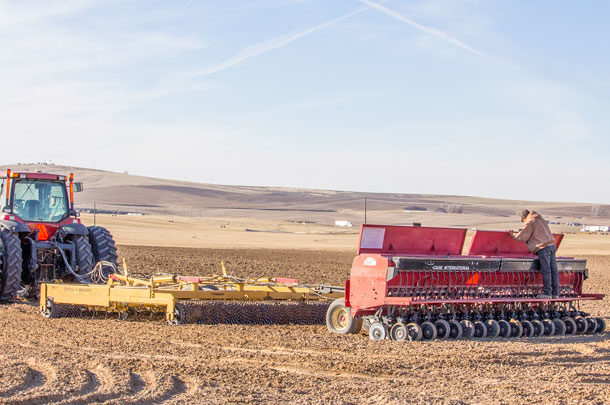A lot of attention is paid to new technologies used to seed row crops like corn and soybeans. However, the accuracy of mechanical grain drills gets much less focus.
As technology has progressed with new seed coatings, improved hybrids and genetic traits such as herbicide resistance, the cost of seed has increased. This cost comes with the benefit of increased yield or improved feed value, but none of that is possible without first establishing a good stand.
The first part to consider on a drill is the meter. While fluted meters are simple and may be perceived as inaccurate, calibration can help them correctly meter the desired amount of seed or fertilizer. Not all drills are equal in their calibration process, though. Be sure to check the operator’s manual for the manufacturer’s recommended calibration procedure.
Grain drills generally fall into one of three calibration processes, each with its own benefits and drawbacks:
- Re-fill method: One of the more common methods is to fill the drill hopper full, seed an acre, then record how much seed is needed to refill the hopper. If the amount of seed needed is different from the target rate, the operator adjusts the drill, then rechecks after the next acre is seeded. While this is probably the easiest method, it has the potential to be very inaccurate. It can be tricky to accurately measure how much seed is needed to get the hopper full again. It is also difficult to allow for any variance for how much the seed may have settled as the drill bounced through the field.
- Single meter method: Another method is to disconnect a single seed tube, put a bucket under the meter, jack up the drill, mark the drive wheel and manually turn it the number of revolutions it would turn in the field to cover an acre. Then the operator weighs the seed in the bucket, multiplies by the number of rows and spacing and calculates the amount of seed that would be planted per acre. This process can be time consuming and tiring due to manually turning the drive wheel. It also can be inaccurate since this calibration method only checks one meter. If there are any variances between meters, it could result in inaccurate calibration.
- Integrated calibration system: A third option is a drill that has a calibration system. These commonly include a mechanism to insert a catch pan under all meters and a crank to easily meter out a target amount of seed for a fraction of an acre. The seed caught in the pans is weighed to see if it matches the target. This system ensures the calibration accounts for all meters, does not require any estimating on the quantities of seed left in the hopper and can be done without manually spinning the drive wheel.
Regardless of how a drill is calibrated, it is an important first step to make sure the proper amount of seed is being planted.
An equally important adjustment on any drill is getting seeding depth set properly. On most drills, this is done by adjusting a handle on each row unit. The handle moves a gauge wheel relative to the disc opener to control how deep the opener goes into the ground. Even small changes in seeding depth can have a big impact on emergence, as demonstrated in recent YouTube videos by the University of Kentucky forage department (KYForages) showing a time lapse of emergence for alfalfa and tall fescue at different seeding depths.
Not all gauge wheels work the same. Depending on field conditions, some systems may perform better than others. Most conventional grain drills gauge depth using the press wheel that trails behind the opener. As the wheel closes the seed trench, it maintains depth on the disc opener.
This system works well in flat fields that have had some tillage done to prepare a consistent seedbed. Since the press/gauge wheel trails behind the opener by several inches, it is unable to respond to rapid changes in terrain. For instance, when there is a bump in the field, the opener has already plowed through it before the gauge wheel reaches it, resulting in the seed being placed too deeply. Similarly, if there is a dip, the opener may come out of the soil, not creating any seed trench at all before the gauge wheel is able to react.
Another type of row unit utilizes a leading gauge wheel in addition to the trailing press wheel, with the opener in the middle to maintain seeding depth. This system acts like a walking beam tandem axle to ensure close ground following and smooth operation, while keeping the disc opener much closer to the desired seeding depth, even in rough or uneven min-till or no-till fields. The leading gauge wheel makes sure the opener does not plow into bumps or come out of the ground at dips, while keeping good pressure on the closing wheel to close the trench.
There are also some drills that have the gauge wheel right next to the disc opener, like a planter. This design works well to ensure the proper seeding depth is maintained. Since the gauge wheel is next to the opener, it can respond to changes in terrain quickly, much like the systems that have both a leading and trailing gauge wheel.
After the rate is set and calibrated and the proper seeding depth is set, the drill should also have the down pressure adjusted. Depending on the drill, this can be done using mechanical springs, a hydraulic system or even pneumatic air bags. Regardless of how it is adjusted, down pressure plays a key role in maintaining seeding depth and ensuring good seed-to-soil contact.
If the down pressure is set too light, row units can ride up out of the ground leaving seeds too shallow and not closing the trench, resulting in poor seed-to-soil contact. Alternatively, if the down pressure is set too high, this can cause gauge wheels to sink into the ground, creating compaction right by the seed or resulting in the seed being placed too deep. Depending on field conditions and drill design, some drills may require additional weights be added to achieve higher down pressures.
Whether seeding oats, wheat, soybeans, forage grasses or alfalfa, you can make the most out of your seed investment by ensuring the grain drill is properly adjusted and calibrated. A few quick adjustments on the drill can make the difference when trying to establish a good stand with a high-forage yield.











